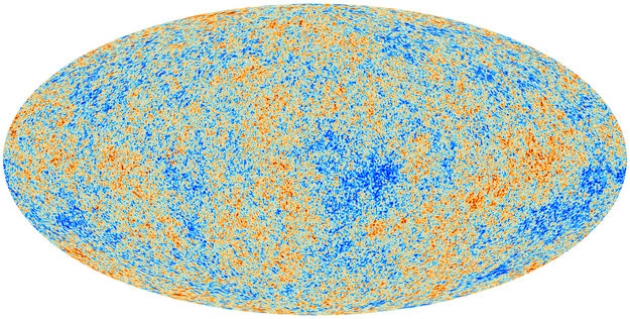
It appears that the universe, like graying humans, gets lumpier as it gets older. At least this appears to be the primary finding from the European Space Agency's Planck Satellite (actually Space Telescope). Thus, the images released last Thursday, showing a heat map of the ‘baby’ universe (as it appeared only 380,000 years after the Big Bang) were startling to say the least. The details of the image show the universe to be 80 to 100 million years older than previously thought and with more light and dark matter. According to the current assay, the universe consists by mass of:
-4.9 % atoms
- 27% dark matter
- 71% dark energy
The last, again, is a form which cannot be assessed for any order. It is most likely a vacuum form of energy.The cosmological "equation of state" (think of something like the equation of state for an ideal gas, e.g. P = nkT) for this vacuum energy is:
w = (Pressure/ energy density) = -1
This is consistent with Einstein's general theory of relativity - which one could say approaches the status of a 'basic law of physics'. In this case, the existence of a negative pressure is consistent with general relativity's allowance for a "repulsive gravity" - since any negative pressure has associated with it gravity that repels rather than attracts. Specifically the term (r + 3p) acts as a source of gravity in general relativity, (where r = energy density, p is gas pressure).
If we set: 0 = (r + 3p) then:
p = -r /3 (or r = - 3p)
and if: p < (r /3) we have gravity that repels
The new image and data peg the age of the Universe at 13.82 billion years — slightly older than the 13.7b years previously estimated. The results strongly support the idea that in the 10−32 seconds or so after the Big Bang, the Universe expanded at a staggering rate — a process dubbed inflation. This would explain why the Universe is so large (actually 66b Ly in spatial diameter), and why we cannot detect any curvature in the fabric of space (other than the tiny indentations caused by massive objects such as black holes).
Launched in 2009, Planck is more than three times more sensitive than the Wilkinson Microwave Anisotropy Probe. Its high-frequency microwave detector is cooled to just 0.1 degrees above absolute zero, which enables it to detect temperature variations as small as a millionth of a degree. These precise measurements show that the Universe is expanding slightly slower than estimated from WMAP's data. The rate of expansion, known as the Hubble constant, is 67.15 kilometers per second per million parsecs, which suggests that the Universe is about 80 million years older than calculated from earlier WMAP images. (The earlier value for H was 70 kilometers per second per million parsecs.
Interestingly, the new data shows the universe is slightly lumpier than previously thought with larger and more heat spots on one side than the other. Cosmologists had previously believed these to be more an observational anomaly (e.g. derived from ‘contamination’ from the Milky Way) than a real effect but now they will have to be taken more seriously.
Bear in mind again, that the Big Bang is not an explosion, but more an expansion in time. Basically, the Big Bang is totally dissimilar to a terrestrial explosion, including all the geometry, kinematics, dynamics. A good article ('Cosmology's 5 Big Things You Need to Know') can be found in the May, 2007 issue of ASTRONOMY magazine(p. 28). As noted therein (p. 31):
"The universe's beginning wasn't an explosion. It was closer to an unfolding or creation of matter, energy, time...and space itself."
The last is especially important! Thus, the unfolding saw the expansion of space with time. Citing an astronomer (Charles Bennett, lead researcher on the Wilkinson Microwave Array Project) also quoted in the piece:
"The Big Bang is not an accurate name for the theory. What this theory describes is the expansion and cooling of the universe. It doesn't describe an explosion at all."
Why was it named the “Big Bang”? Blame it on George Gamow, the Russian cosmologist who conferred the tag when he helped develop the theory.
No comments:
Post a Comment